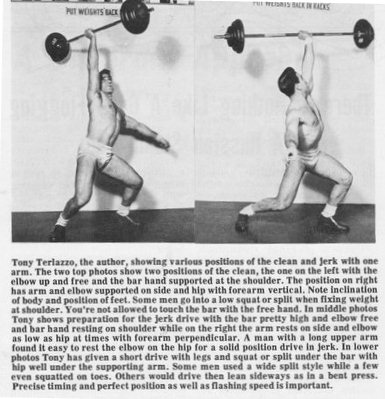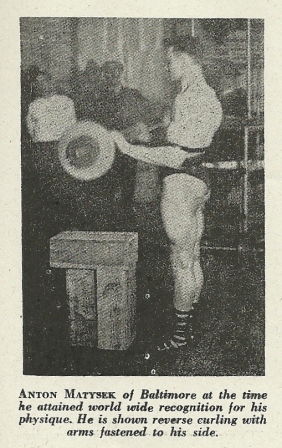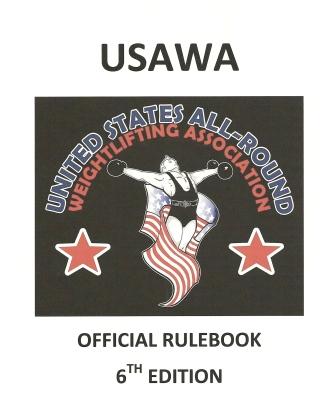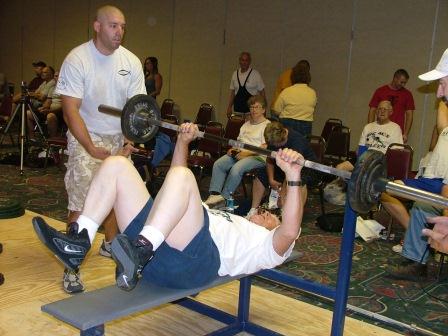by Al Myers
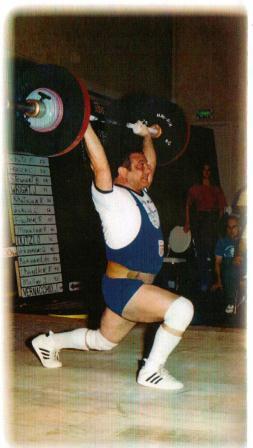
John Vernacchio completing a Clean and Jerk.
It’s been a sad past couple of weeks with the passing of John Vernacchio. He had many friends in the all-round weightlifting community. However, it is a glorious occasion as well, because I know he is in heaven right now meeting family members and friends that have gone before him. My bet is that he and Howie are having a hard training session together right now – with John pumping out those famous presses of his, while Howard is hooking up the belts to do a Harness Lift.
I would like to take today and share some of the accomplishments that John has achieved throughout his lifting career. Most of this will be with his time lifting in the USAWA as I don’t have much information on his lifting before that. However, Joe Roark (Ironhistory.com) recently provided some important information on John that I wasn’t aware of prior to his USAWA involvement. Initially John did some competitive bodybuilding in his early weightlifting days. These were his physique competition accomplishments:
Mar 12, 1960 was 11th at Mr. Jr. Middle Atlantic
Dec 09, 1961 was 7th in an Open Physique contest in Norristown, PA
Oct 13, 1962 was 18th in an Open Physique contest in Philadelphia
Apr 04, 1964 was 21st in a physique event at Holy Saviour
After that John become involved with Powerlifting and Olympic Lifting, lifting for the Holy Savior Weightlifting Team. Joe Roark also provided some contest history of PL and Olympic meets that John competed in in the early 60’s:
Oct 19, 1963 at Atlantic Coast PL: curl 140, Sq 360, BP 200, Total 700 for 6th place in the 181 class
Mar 21, 1964 was last in an Open PL contest in Pittsburgh where his only successful lift was a 380 squat
Feb 13, 1960 in the 148 class at the Greater Philidelphia Open 200-170-235 = 605
In John’s Hall of Fame Bio, it stated that he won his first National Championship in 1961, at the National Collegiate WL Championships. John also stated in his bio that his two favorites lifts were the Military Press and the Squat – which shows why John eventually found his calling in All-Round Weightlifting by enjoying two such different lifts the best. Most of his Powerlifting was done in his club – the Valley Forge WL Club. This continued into the early days of the USAWA, as John usually brought a team from his club to represent in all-round meets. The Valley Forge WL Club was a member club of the USAWA from 1989 to 1995.
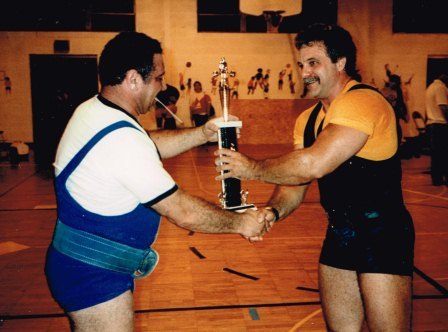
John Vernacchio (left) presenting Jerry Turner (right), a member of the Ambridge Club his award after a meet John was promoting.
John was one of the pioneer leaders of the USAWA. He promoted the VERY FIRST USAWA National Championships in 1988. That is still a meet the “old-timers” tell stories about. He went on to promote three USAWA National Championships (1988, 1989, & 2004). At this years Nationals, a special award was given to John for this contribution, as he was one of 4 that have promoted the most, at 3, USAWA National Championships. I am really glad now that he received this final award from the USAWA before his death. He deserved it!
John was the second President of the USAWA, elected in January 1989 and serving till the end of 1992. He also served as one term as the IAWA Vice President (elected in 2000). In addition, he has served several terms on the IAWA Technical Committee. He did several IAWA promotions as well. He promoted three IAWA World Championships (1989, 1991, & 1997), as well as three Gold Cups (1992, 1996, & 2003). John was “no stranger” to competing overseas. Numerous times he attended the IAWA Worlds when it was held out of the states. I did some research and have discovered John competed in 12 World Championships! He had a continuous 10 year run from the the first one in 1988 in Leicester, England to 1997 Worlds in Collegeville, PA. This included World Meets in Glasgow, Scotland twice and England three times. His last two World entries came in 2002 & 2005 in Lebanon, PA. John also promoted many Powerlifting meets and Olympic lifting competitions. He promoted the 1987 National Masters WL Championships as well as the 1991 Pan American Masters WL Championships. He promoted multiple Eastern Masters PL and WL Championships.
John was an active participant in the USAWA National Championships as well. All together – he competed in 15 Championships (1988, 1989, 1990, 1991, 1992, 1993, 1994, 1996, 1997, 1998, 2002, 2003, 2004, 2005, & 2007). He won numerous Best Lifter Age Group Awards through the years: 1988 Best Lifter 50-54, 1990 Best Lifter 50-54, 1992 Best Lifter 55-59, 1993 Best Lifter 55-59, 1997 Best Lifter 60-64, 2004 Best Lifter 65-69. He probably won more Best Lifter Awards than this number, as this information came from the old meet results and often not all Best Lifter Awards were recorded. His highest overall placing at the USAWA Nationals was 4th overall at the 1988 Championships. He had 4 total “top ten” finishes at Nationals: 4th in 1988, 10th in 1989, 6th in 1990, and 8th in 1997. John “V” also really supported the IAWA Gold Cup. He competed in 13 Gold Cups, including Gold Cups in England and Scotland. He entered the “very first” Cup in 1991 directed by Howard Prechtel in Lakewood, Ohio and performed a 190 Kg 12″ Base Squat.
